Ijraset Journal For Research in Applied Science and Engineering Technology
- Home / Ijraset
- On This Page
- Abstract
- Introduction
- Conclusion
- References
- Copyright
Image Contrast Enhancement Using Artificial Hummingbird Algorithm
Authors: Laishram Avinash Singh, Dr. Harsha M. V
DOI Link: https://doi.org/10.22214/ijraset.2024.63922
Certificate: View Certificate
Abstract
Image enhancement plays an important role in medical imaging, satellite image processing, and computer vision. These fields require high-quality images to improve the visibility of details, which is essential for accurate analysis and interpretation. Contrast adjustment, histogram equalization, and gamma correction are the traditional image enhancement techniques that are widely used. However, these methods often fall short, particularly when applied uniformly across diverse images, as they may not always yield the best results. We provide a unique picture enhancing method based on the Artificial Hummingbird Algorithm (AHA) to overcome these drawbacks. The AHA is inspired by the foraging behaviour of hummingbirds, which are known for their efficient and adaptive search strategies. This bio-inspired algorithm leverages strategies to optimize the gamma correction parameter, aiming to enhance image contrast and overall visual quality. The aim is to optimize the gamma correction parameter to maximize fitness values derived from several image quality metrics, including Structural Similarity Index Measure (SSIM), Feature Similarity Index Measure (FSIM), and Peak Signal-to-Noise Ratio (PSNR). The AHA operates through a population-based approach, where each individual in the population represents a potential solution with a specific gamma value. Initially, a population of random gamma values is generated, and each value is used to enhance the image, followed by evaluating its quality using the combined fitness function. The algorithm uses three distinct foraging strategies to efficiently explore the solution space: guided, territorial and migration foraging. Guided foraging helps steer the search towards promising areas, while territorial foraging refines the local search. Migration foraging periodically resets some individuals to avoid premature convergence and ensure a comprehensive exploration of the solution space. Through iterative adaptation and evolution, the AHA continuously updates and refines the best gamma value found, leading to significantly enhanced images. Experimental results demonstrate that the AHA-based technique offers substantial improvements in image quality, with better contrast, sharper details, and higher scores in the quality metrics compared to traditional methods, making it a robust and efficient solution for high-quality image processing tasks.
Introduction
I. INTRODUCTION
A. Introduction
Image contrast enhancement seeks to enhance the overall image quality by augmenting the distinction between the brightest and darkest areas, which can be affected by factors like illumination and noise during image capture. Higher contrast indicates a greater separation factor, while lower contrast suggests a smaller one. This technology is essential in various applications, such as producing high-quality photos in low-light conditions when embedded in digital cameras. Due to its significance, many algorithms have been developed, with histogram equalization being a widely used method. Histogram spikes may be handled and distortion can be decreased without the need for empirical parameter modifications with adaptively adjusted histogram equalisation, which adjusts the probability density function of the original picture based on average intensity values. Additionally, different contrast and sharpness techniques can be used to increase image intensity levels, and grey transformation functions can be combined with evolutionary algorithms to enhance low-quality images by optimizing the mapping of grey levels.
In the recent years, numerous optimisation techniques have been designed for various problems, broadly divided into algorithms that are deterministic and meta-heuristic. Newton's techniques and gradient descent are two examples of deterministic algorithms rely on specific mathematical functions and provide consistent outputs for given inputs without any randomness. While effective at finding local optima in certain nonlinear problems, these methods are limited by their inability to escape local optima and their reliance on derivative information.
As perfect substitutes for deterministic approaches, meta-heuristic techniques have been developed due to their ability to balance the design space exploration and exploitation through iterative operations. These methods have gained popularity across domains such as engineering design, finance, energy, scheduling, image processing, and optimum control.
They are more appropriate for transitioning between exploration and exploitation because of their innate unpredictability, which makes them less vulnerable to beginning conditions. Additionally, their black-box approach focuses on inputs and outputs without requiring structural knowledge of the problem, enabling them to find global optimal solutions effectively. Bio-inspired algorithms, which mimic the behaviour of living organisms, have been particularly influential in developing robust optimization models.
B. Artificial Hummingbird
Inspired by hummingbirds' foraging habits, the Artificial Hummingbird Algorithm (AHA) is a novel optimisation approach. Hummingbirds are able to effectively search their surroundings for nectar because to their distinctive flying patterns, which include axial, diagonal, and omnidirectional motions. AHA seeks to outperform conventional techniques in the solution of challenging optimisation issues by imitating these dynamic and adaptable foraging patterns. By using the hummingbird's skill at striking a perfect balance between the design space exploration and exploitation, this bio-inspired algorithm improves its capacity to avoid local optima and provide reliable, high-quality solutions.
The applicability of AHA is wide-ranging, but this focuses specifically on image improvement. Image augmentation is enhancing an image's visual appeal to make it better suited for interpretation and analysis. AHA enhances visual quality metrics like the Structural Similarity Index Measure (SSIM), Feature Similarity Index Measure (FSIM), Peak Signal-to-Noise Ratio (PSNR), and others by optimising the gamma correction parameter. The outcomes show how well AHA may perform in comparison to more conventional optimisation methods, making it a valuable tool for improving images and resolving other challenging optimization problems.
C. Literature Review
Pankaj Kandhwaya et al. [1] suggested a unique framework for enhancing contrast and crisp edges in medical pictures based on the Krill Herd (KH), which is presented in this research. This research suggests a plateau limit and a fitness function to obtain the greatest picture enhancement. Utilizing the histogram values together with an adjustable parameter, a new plateau limit is applied. The leftover pixels are redistributed to the histogram bins with the closest vacancy. The KH algorithm explores to update the tunable parameter based on fitness function that uses edge, entropy, GLCM contrast, and GLCM energy of the image to obtain the best performance metrics of the anatomical photographs. The findings demonstrate that, both qualitatively and numerically, outperforms other techniques.
Upendra Kumar Acharya and Sandeep Kumar [2] have proposed Particle Swarm Optimization Texture based Histogram Equalization (PSOTHE) technique to enhance the MRI brain image quality. The primary benefit of the suggested optimised framework is that, without the need for human input, it uses PSO algorithm and recommended fitness function to determine the threshold and constraint parameters frequently. As a result, the suggested method produces an output image that is balanced, improved, and more adaptive for a variety of images. In the suggested work, the non-texture's impact is muted to lessen the undesirable artifacts. Images from an MRI are textured. Therefore, a texture-oriented histogram equalization is provided in this research in order to preserve the texture feature or edge contents. The selection of weighted constraints to alter the PDF has been made in order to regulate the improvement level. Thus, it appears that the enhanced image does not have a saturation issue. In the end, a unique weighed histogram is created that resembles the shape of input image and shows improved image has less noise. The suggested PSO technique outperforms other current methods Regarding visual quality, contrast, entropy, PSNR, AMBE, SSIM, FSIM, EME and adaptiveness, according to both visual analysis and quantitative evaluation. Therefore, this method is better for enhancing the better features of low contrast images, identifying abnormalities, detecting brain tumors, and making medical diagnoses. It can also be applied as a brain tissue segmentation pre-processing method.
Wan Azani Mustafa et al. [3] suggested that evaluating the quality of visual information is crucial for many computer vision and image/video processing applications. An overview of the history and relevant research in the field of image quality assessment (IQA) is provided in this publication. Most of the reported IQA techniques have been served on unbiased assessments of quality. The key objective of the literature study stood to explore and acquire further knowledge on the benefits of evaluating image quality. It can be concluded from this experiment that SNR and PSNR are compatible with the contrast image that was obtained. ME measurement is compatible with segmented images. The IQA on the tested images was gathered for this study, and they were then classified.
Jia Chen et al. [4] suggest that improving the reduced contrast level of photographs during image acquisition is the aim of image contrast enhancement. In this study, we consider image contrast enhancement to be an optimization problem, and we use ABC technique to obtain the ideal result. The suggested method makes two contributions.
First, this study proposes a new objective fitness function, considering that the fitness function is essential to assessing the quality of the improved image. More crucially, the image transformation function directs the artificial bees' seeking actions. Second, it is essentially to produce novel intensities of pixels from the original input image for the improved image. This study uses a parametric image transformation function, which reduces the number of parameters the ABC method must search for to only the ideal ones. The traditional ABC-based image enhancement techniques use the entire space of image intensity levels. Research is done extensively to show that the suggested method works better than traditional image contrast enhancement techniques in achieving higher objective performance metrics and better visual image quality.
Chenyi Zhao et al. [5] have proposed a novel approach to medical picture improvement using gradient modulation and luminance-level modulation. This paper primarily contributes in two ways: first, it proposes a unique LM operation that might lower the dynamic luminance level range; second, It significantly enhances the features and textures of the pictures by employing gradient modulation (GM) in an upgraded fast local Laplacian filter. The suggested method's execution was objectively and qualitatively compared to well-known enhancement techniques such as FLLFs, 2DHE, HMLCE, and LGS-Curve. This comparison shows that LM&GM outperforms the other techniques in terms of avoiding artifacts and halos, boosting contrast, and enhancing details. The benefits of LM&GM's stability and viability are further illustrated by temporal comparisons between various approaches.
Eyob Mersha Woldamanuel [6] has proposed the WCA-based image enhancement method. It was displayed and contrasted with alternative approaches in order to improve grayscale, dark images. By combining WCA with intensity transformation and fitness function, an innovative method of image enhancement was achieved. Given that the HVS is the output's ultimate user, perceptual quality metrics are largely used to evaluate the picture enhancement performance of a given technique as well as the quality of the generated image. Accordingly, the proposed WCA-based method performed better than the others. In terms of SSIM and FSIM, it was also discovered that the recommended method performed well than any other technique—aside from the HE and CLAHE procedures. In most photos, the suggested approach even outperformed those solutions in those metrics. In contrast to HE and its derivative approaches, it did not do as well regarding IFC and VIF. The suggested approach was discovered, surprisingly, extra steady than the PSO and APSO approaches, with a faster convergence time. Because the suggested technique performs better at boosting darker grayscale photos, it can therefore be applied to a wider range of grayscale images, including night vision, CCTV security, medical, and license plate images. This work concluded by recommending additional research on the suggested WCA-based approach.
Pourya Hoseini and Mahrokh G. Shayesteh [7] have proposed a hybrid approach that combines the metaheuristics of Simulated Annealing (SA), Ant Colony Optimization (ACO), and Genetic approach (GA) to increase picture contrast. The global transformation of the input intensities yields contrast enhancement. The transfer functions that relate the input intensities to the output intensities are created by ant colony optimisation. The transfer functions produced by ant colony optimisation are changed by using simulated annealing as a local search technique. Furthermore, the evolutionary process responsible for the traits of ants is attributed to genetic algorithms. The fitness function that is being used works automatically and generally balances the contrast and naturalness of the photographs. From both subjective and objective perspectives, new approach generates pictures with better contrast than previously described methods, according to the results. Furthermore, the suggested technique maintains the input photographs' natural appearance.
Kankanala Srinivas and Ashish Kumar Bhandari [8] have proposed algorithms for improving low-light photographs that aim to extract useful information for computer vision applications while creating visually appealing images. It's difficult to get better at taking pictures in low light. Unquestionably, the current approaches to quality enhancement are inefficient and have significant computational complexity, which detracts from their aesthetic appeal. This study presents a low-light picture improvement framework that is both computationally efficient and simple, with the goal of reducing distortions and improving visual quality. An adaptive sigmoid transfer function (ASTF), which is derived from the sigmoid activation function of neural networks, is employed to do this. ASTF and a Laplacian operator are combined to create images with improved colour and contrast. Comparing the suggested strategy with cutting-edge techniques demonstrates its efficacy.
Ammar Mansoor Kamoona and Jagdish Chandra Patra [9] have proposed a novel enhanced cuckoo search (ECS) algorithm for image contrast enhancement. Furthermore, it provides a new search area for the local/global enhancement (LGE) transformation parameters that require optimisation. Several low-contrast test photos are used to test the proposed ECS algorithm, and the CS method's performance is contrasted with its own. Afterward, we use a global transformation and the suggested LGE transformation to compare the artificial bee colony algorithm's performance with that of the ECS method. HE, CLAHE, PSO, CS, modified CS, and CS-PSO algorithms are among the image enhancement methods that are compared with the ECS algorithm, in the final round of performance evaluation.
We have demonstrated the ECS algorithm's superiority in each scenario using a number of performance metrics.
Madheswari Kanmani and Venkateswaran Narsimhan [10] have proposed a method of enhancing contrast that blends evolutionary theory with traditional contrast enhancement. The primary goal of this work is to use particle swarm optimisation in conjunction with adaptive gamma correction to improve an image's features and information richness. By selecting the ideal gamma value, a well-known method for preserving a picture's average brightness is gamma correction and creates photographs that appear natural. To determine the ideal gamma value, particle swarm optimisation based on swarm intelligence is used. The parameters are edge and information content (entropy) in suggested technique that are used to create the fit function. The suggested approach is contrasted with cutting-edge methods in terms of CNR, Homogeneity, Contrast, WPSNR and EME. Simulation outcomes shows suggested particle swarm optimisation technique enhances the information contained in the image and improves the overall contrast of the image. The suggested method highlights an image's hidden elements and is more suitable for usage than current contrast enhancement methods in satellite imaging and night vision applications.
Krishna Gopal Dhal et al. [11] have suggested the field of image processing, particularly in image enhancement, that efficient searches in complex domains are needed for optimal solutions. It highlights the absence of a universal technique or measurement criterion for image enhancement, making the problem challenging and time-consuming. To address this, researchers have turned to Nature-Inspired Optimisation Algorithms (NIOAs) to formulate and solve image enhancement problems. This emphasises the significance of NIOAs in revolutionizing the field and mentions that the study provides a current review of their application in image enhancement, including a discussion of key issues in formulating NIOAs-based models.
Yuanping Zhou et al. [12] have proposed a fresh approach to maximizing a medical image's contrast. This study utilised a newly introduced algorithm to optimally choose the gamma value. This selection process involved considerations of Edge content, multi-objective optimization, and entropy. The primary objective is to enhance the Gamma correction method by utilizing a redesigned World Cup Optimisation (WCO) algorithm. The focus is on improving the highlighting and enhancement of image information and details. Gamma correction, known for its effectiveness in contrast enhancement, relies on the accurate selection of the Gamma coefficient for optimal results. The efficiency of the presented method was evaluated by comparing simulation results using five cutting-edge techniques. The assessment involved measures such as contrast, homogeneity, WPSNR, EME, and CNR. The conclusive findings indicate that the introduced multi-objective optimisation algorithm enhances image contrast quality, offering further information and details compared to other similar procedures.
Weiguo Zhao et al. [13] have proposed the artificial hummingbird algorithm (AHA), a novel bio-inspired optimisation algorithm, to address optimization problems. The AHA algorithm mimics the unique flight characteristics and cunning foraging techniques of hummingbirds found in the wild. Three different flight skills—axial, diagonal, and omnidirectional flights—that are used in foraging tactics are modeled. In addition, guided, territorial, and migratory foraging techniques are used, and a visit table is constructed to mimic the hummingbirds' ability to remember where to find food. AHA is validated using two sets of numerical test functions, and the results are contrasted with those obtained from alternative techniques. The evaluations show that AHA finds high-quality solutions with fewer control parameters and is more competitive than other meta-heuristic algorithms. Furthermore, AHA's performance is verified in ten difficult engineering design case studies. The outcomes display the higher efficiency of AHA over current optimisation in terms of computation load and solution accuracy methods used in writing. To further illustrate AHA's practical utility, the study also looks at how it might be applied to the design of hydroelectric operations.
D. Objectives
The objective of Artificial Hummingbird Algorithm (AHA) is to enhance an input image by optimizing the gamma correction factor based on the behaviour of hummingbirds. The process involves converting the image to grayscale, resizing it, and initializing a population of potential gamma values. The algorithm iteratively updates these gamma values through guided, territorial, and migration foraging strategies to maximize a fitness function that assesses image quality. The best gamma value is then used to enhance the image and its performance metrics effectively.
E. Organisation of Report
The report is organized into five chapters including this chapter.
Chapter 2 comprises of Artificial Hummingbird Algorithm (AHA).
Chapter 3 comprises of AHA-Based Image Enhancement Technique.
Chapter 4 comprises of result obtained and its analysis.
Chapter 5 consists of conclusion and future scope of the work.
F. Conclusion
An overview of ICE and the fundamental concepts related to the AHA optimization algorithm is presented. The objectives of the project are formed and organization of the report is presented.
II. ARTIFICIAL HUMMINGBIRD ALGORITHM
A. Inspiration And Background of The AHA
Artificial Hummingbird Algorithm (AHA), introduced in 2021, is a metaheuristic bio-inspired optimization algorithm. This algorithm stimulates the hummingbird’s flight skills and food-foraging behaviour in nature.The natural behavior of Hummingbirds is shown in Fig. 2.1. Despite being the tiniest birds in the world, hummingbirds are amazing creatures. Hummingbirds are the most intellectual species on the planet, even cleverer than people, If the ratio of the brain to the body determines intelligence. There are more than 361 species of hummingbirds that is the second largest family of birds. Hummingbirds smallest species is about 5cm and largest species is about 23cm.Hummunghird brain is 42 % of its body weight. So, the hippocampus of a hummingbird’s brain is far bigger and has a remarkable memory because they are little but incredibly intelligent birds with the largest brain in proportion to body size of any bird.
Every hummingbird in a given area is able to recall certain details about individual flowers, when it was last visited. Regarding food sources, the birds may also recall geographical and chronological information. Hummingbirds regularly consume huge quantities of flower fluids to provide them with adequate energy for soaring and also eat insects to add protein & minerals to their diet.
Hummingbirds have good color vision and they are attracted to bright colors like red, orange. They have no sense of smell but they can hear better than humans. Hummingbirds have excellent flight skills than any other birds. They can move forward, backward, up, down and sideways. Its average lifespan is 5 years and they have tiny legs they cannot walk or jump and also they can fly 20 to 30 miles per hour. Therefore, flying abilities, memory, and foraging tactics of hummingbirds serve as the primary sources of inspiration for the AHA algorithm.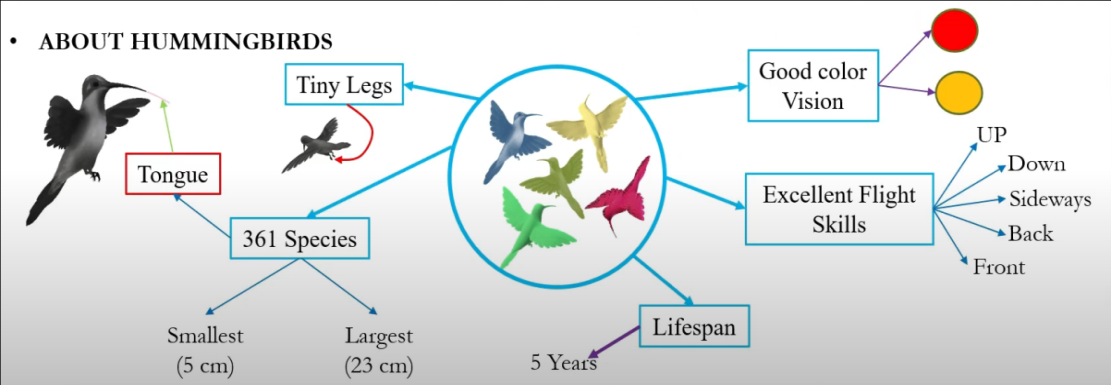
Figure 2.1: Natural behavior of Hummingbirds
1) AHA Main Components
- Hummingbirds: Hummingbirds have excellent memories; they can recall every flower and the duration required to fully bloom. Hummingbird is also able to recall the duration of time that each food source is ignored on its own. In AHA, each hummingbird has a specific place where it can be fed; for simplicity’s sake, we’ll assume that the hummingbird and the food source are in the same spot.
- Food sources: Hummingbirds assess various individualities of food sources, i.e. nectar quality, nectar refilling rate, the final instance they visited a flower, and the content of the flower. In this simplified scenario, It is believed that every food source has the same quantity and type of identical flowers. The evaluation of a good food source is based on its nectar refilling rate, which is represented by fitness values calculated for each food source. It is important to note that both the hummingbird and the food sources are considered to have the same position, meaning they are identical. The solution vector is determined by the selection of good food supply and the level of fitness represents the nectar refilling rate for each individual food source.
- Visit table: The visit table indicates the visit level for every food source for various hummingbirds. The duration of time a hummingbird has not visited a certain food source is indicated by this level. A hummingbird will give preferential visits to a food source that has a great visitation level.
Of the food sources with the same greatest visit level, a hummingbird would often visit one with the highest rate of nectar refilling in order to get more nectar. Every hummingbird may find its designated food source with the help of the visit table. Generally, every iteration updates the visit table.
2) AHA FORAGING BEHAVIOR
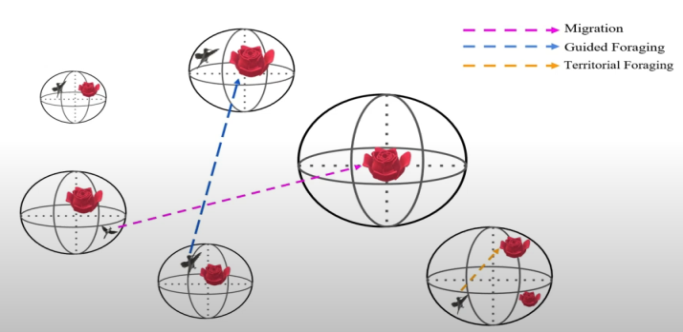
Figure.2.2: Three AHA foraging behaviour
Three AHA foraging behaviour is shown in Fig.2.2.
- Migration Foraging: When resources become scarce, hummingbirds migrate to new locations, enabling them to explore new areas and potentially discover more abundant food sources.
- Guided Foraging: Hummingbirds tend to revisit previously rewarding food sources, guiding their search towards areas with higher nectar concentrations.
- Territorial Foraging: Hummingbirds defend their territories and explore the immediate surroundings for food sources, effectively exploiting the local search space.
These foraging behaviors inspired the development of the AHA, It mimics the variety of hummingbird foraging techniques in an attempt to strike a balance between exploration and exploitation in the pursuit of the best answers.
B. Algorithm and Mathematical Model
1) Initialization
A colony of n hummingbirds is started at random and put on n food sources in the following manner:
xi=Low+r*Up-Low i=1,…….n (2.1)
(2.1)
where the position of the ith food source is indicated by xi
food source is indicated by xi , a random vector in [0, 1] is r, and Up and Low represents the upper and lower bounds for a d-dimensional problem, respectively.
, a random vector in [0, 1] is r, and Up and Low represents the upper and lower bounds for a d-dimensional problem, respectively.
The following is how the food sources visit table is initialised:
VTi,j=null if i=j0 if i≠ji=1,..,n;j=1,…,n (2.2)
(2.2)
Where, for i=j , VTi,j
, VTi,j shows nil, indicating that in its chosen feeding site, a hummingbird consuming food; for i≠j
shows nil, indicating that in its chosen feeding site, a hummingbird consuming food; for i≠j , The hummingbird on iteration ith
, The hummingbird on iteration ith has just visited the jth
has just visited the jth food source, as shown by VTi,j
food source, as shown by VTi,j = 0
= 0
2) Guided Foraging
Naturally, hummingbirds go towards food sources that provide the greatest nectar. This suggests that the hummingbird shouldn't have visited the target food source for some time and its nectar content ought to be high.

Figure 2.3: Hummingbirds exhibit three distinct flight behaviour’s (a) axial flight, (b) diagonal flight, and (c) omnidirectional flight.
A hummingbird using the AHA initially determines which food sources have the highest amounts of visits in order to facilitate guided foraging. The hummingbird flies towards its selected food source and feeds there. The AHA method represents omnidirectional, diagonal, and axial flights using a direction switch vector. This vector controls the availability of one or more directions in the d-dimensional space. The ability to transfer any flying direction onto any of the three coordinate axes is known as omnidirectional flight. While all birds are able to fly in all directions, only hummingbirds can fly in both axial and diagonal directions. These patterns of flying are transferable to a d-dimensional space, where the following is the definition of axial flight:
Di=0 else1 if i=randi([1,d])i=1,….,d (2.3)
(2.3)
The definition of diagonal flight is:
Di=0 else1 if i=Pi, j∈1,k, P=randpermk, k∈[2,r1*d-2+1]i=1,….,d (2.4)
(2.4)
The definition of omnidirectional flight:
Di=1 i=1,…,d (2.5)
(2.5)
where, randi([1,d]) produces a random integer from 1 to d, with rl being a random number in (0,1], randpermk
produces a random integer from 1 to d, with rl being a random number in (0,1], randpermk generates a random permutation of integers from 1 to k. In a d-D space, the diagonal flight lies inside a hyper rectangle that is enclosed by any coordinate axis from 2 to d-1.
generates a random permutation of integers from 1 to k. In a d-D space, the diagonal flight lies inside a hyper rectangle that is enclosed by any coordinate axis from 2 to d-1.
The following is used to simulate directed foraging activity and a potential food source:
vit+1=xi,tart+a*D*(xit-=xi,tart (2.6)
(2.6)
a~N(0,1) (2.7)
(2.7)
xit is a representation of the location of the ith
is a representation of the location of the ith food source at time t. Similarly, The target food source that the ith
food source at time t. Similarly, The target food source that the ith hummingbird seeks to reach at that particular moment is indicated by xi,tar
hummingbird seeks to reach at that particular moment is indicated by xi,tar (t). Variable a
(t). Variable a possesses a mean of 0 and a standard deviation of 1, indicating a normal distribution. With the use of various flight patterns, the aforementioned equation represents hummingbirds' guided foraging and allows each present food source to adjust its position with respect to its intended food source. The most recent location update for the ith
possesses a mean of 0 and a standard deviation of 1, indicating a normal distribution. With the use of various flight patterns, the aforementioned equation represents hummingbirds' guided foraging and allows each present food source to adjust its position with respect to its intended food source. The most recent location update for the ith food source is as follows:
food source is as follows:
xit+1= xit f(xit)≤f(vi(t+1)) vit+1 f(xit)>f(vit+1) (2.8)
(2.8)
where f(.) is the function fitness value. Equation (2.8) shows that if the prospective food source's rate of nectar replenishment is higher than the current one, the hummingbird will abandon the current food source and stay at it.
3) Territorial Foraging
If the flower nectar has been eaten, a hummingbird is more likely to search for a new food source than to visit other food sources after visiting its target food source. Consequently, hummingbird may simply relocate its surrounding area inside its own territory and can discover an alternative food supply that could be an improved alternative to its existing one. The following is the mathematical equation that represents the territorial foraging strategy of the hummingbirds involves their local hunt for a possible food source:
vit+1=xit+b*D*xi(t) (2.9)
(2.9)
b~N(0,1) (2.10)
(2.10)
In this case, normal distribution N (0, 1) governs the territorial component b, which has a mean of 0 and a standard deviation of 1.
4) Migration Foraging
The migration coefficient is defined using the AHA algorithm. If the number of iterations exceeds the specified value of the migration coefficient, the hummingbird who locates at the food source with the lowest rate of nectar replenishment will move to a new food source chosen at random throughout the search space.
The following describes a hummingbird's journey foraging from the source with the lowest rate of nectar replenishing to a new source created at random:
xwar(t+1)=Low+r*Up-Low (2.11)
(2.11)
Where the food source with the population's lowest rate of nectar replenishment is xwar . When deciding whether to do the migration in AHA, there is just one control parameter that has to be determined in addition to the two common parameters—the population size and the maximum number of repetitions.
. When deciding whether to do the migration in AHA, there is just one control parameter that has to be determined in addition to the two common parameters—the population size and the maximum number of repetitions.
Assume that there is 100% probability of selecting between territorial and directed foraging, and that the likelihood of visiting each source in the guided foraging is the same. In the worst situation, after two or more repeats, a hummingbird may choose to feed from the same source as its target. The migrating foraging method must be used in this situation in order to enhance stagnation and broaden the search field. Therefore, it is advisable to define the migration coefficient as follows in respect to population size:
M=2n (2.12)
(2.12)
C. PSEUDOCODE OF AHA
As part of the AHA process, an initial visit table and a set of arbitrary solutions are created. During each repetition, there is a 50 % chance of either territorial or directed foraging taking place. Directed foraging enables hummingbirds to navigate towards their preferred food sources, which are based on the visit table and the nectar replenishment rate. However, territorial foraging encourages hummingbirds to go outside of their own neighbourhoods. Foraging migration occurs every 2n iterations. All foraging behaviors utilize the flying abilities of omnidirectional, diagonal, and axial movements. Throughout the process, actions and computations are performed interactively until the termination condition is met. As an approximation of the global optimum, eventually the food source with the highest rate of nectar replenishment reappears.
Initialization, fitness evaluation (c), hummingbirds' location update, number of hummingbirds in the area (N), the most iterations possible (T), and the range of variables (d) all affect AHA algorithm's computing cost. The following is an expression of AHA's total computational complexity:
OAHA=Oproblem definition+Oinitialization+Otfunction evaluation+Otguided foraging+Otterritorial foraging+Otmigration foraging=O(1+nd+Tcn+12Tnd+12Tnd +Tnd2n
+Tnd2n )≅O(Tcn+Tnd+Td2)
)≅O(Tcn+Tnd+Td2) (2.13)
(2.13)
The corresponding flow-chart of the proposed AHA is as shown in Fig. 2.4.
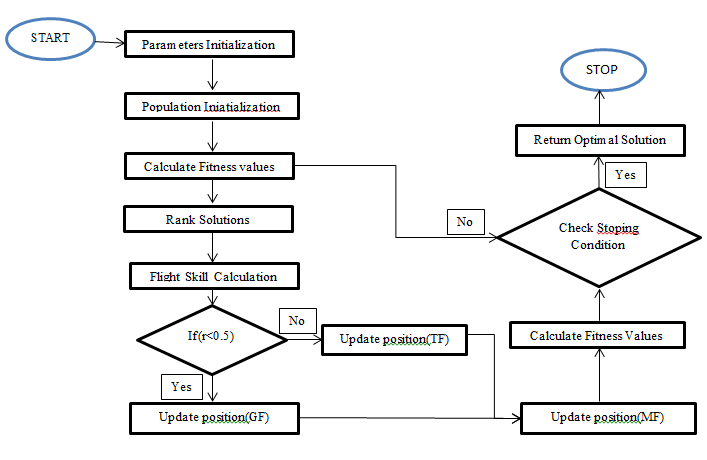
Figure.2.4: Flowchart of the AHA.
D. Conclusion
The basic understanding of the AHA is presented in this chapter and the precise application of AHA to the image enhancement problem, including how to formulate it as an optimisation task and create a suitable fitness function for function for evaluating the enhanced picture quality will be covered in the upcoming chapter.
III. AHA-BASED IMAGE ENHANCEMENT TECHNIQUE
The primary goal of the current study is to increase image contrast so that the final product may be processed further in a computer-aided diagnosis (CAD) system. Contrast enhancement is a pre-processing step in CAD system and has been given a less emphasis. However, the contrast enhancement also plays a significant part in improving the efficiency of a CAD system. The primary objective of a pre-processing stage is to highlight the object of interest in the medical images so that they can be processed further for accurate detection and diagnosis. Therefore, a contrast enhancement scheme is investigated for contrast enhancement of images that utilizes power-law relation as the gray-level transformation function. The power–law relation which is also called gamma transformation is defined in Eq. (3.1).
Iout = Iγin (3.1)
Where Iout is the output image, the image input is Iin and γ signifies the gamma parameter that alters the contrast of the output picture and affect the transfer function's slope.
For each image, the ideal value γ of the power-law transformation is found using an optimisation problem for contrast enhancement that is based on a fitness function given by equation (15).
F(Ie) = log(log(S(Ie))).E(Ie).H(Ie).C(Ie) (3.2)
where, S(Ie) = image of sum of edge intensities
E(Ie) = enhanced image of number of edge pixels
H(Ie)= enhanced image of entropy value
H (Ie)=i=0225hilog2(hi) (3.3)
(3.3)
C(Ie) = enhanced image of contrast value
C(Ie)=i=0NBC(Bi)
where, Bi=ith image block
NB=total no. of image blocks.
C (Bi)=(r,c)∈BinCr,c=(r,c)∈BiIe(r,c)⊗FbIe(r,c)⊗Fl 
where, ⊗ =convolution operator
Fb =band pass filter
=band pass filter
Fl  =low pass filter.
=low pass filter.
Two Gaussian functions, Fl and Fb, with different sigma values, σ1, σ2, as
σ1=L*max?[M,N]v2
σ2 = σ1 × L, where the frequency at which the pass band of the underlying band pass filter peaks is v ∈ [0, σ] and M and N are the image's row and column counts. A binary value is assigned to each picture block once the contrast value has been computed.
The framework of the proposed image enhancement process is highlighted in figure 3.1. An input image is supplied to the contrast enhancement module which is based on the power-law transformation.
As mentioned the parameter γ controls the contrast of the output image, the proposed framework is an optimized power-law transformation based contrast enhancement procedure in which nature-inspired optimization algorithms are incorporated to generate optimal γ for different input images.
Although there are many nature-inspired algorithms in the literature, we have selected a popular recently proposed algorithm: adaptive humming bird algorithm (AHA). The framework and general procedure of the optimized contrast enhancement algorithm using AHA are shown in Fig. 3.1 and Fig. 3.2, respectively.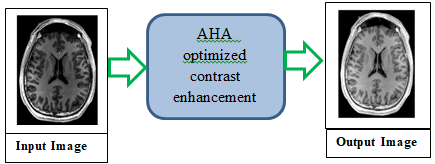
Figure 3.1: Proposed contrast enhancement framework.
|
|
Figure.3.2: An optimized power-law transformation based contrast enhancement algorithm.
.
IV. EXPERIMENT RESULTS AND DISCUSSION
The image enhancement approach is executed using MATLAB2017a and verified on six different images. To confirm the performance, the suggested method of optimised contrast enhancement is compared against other cutting-edge approaches like adaptive histogram equalisation and histogram equalisation. The analogy has been presented in terms of quantitative metrics such as Structural Similarity Index Measure (SSIM), Feature Similarity Index Measure (FSIM), and Peak Signal-to-Noise Ratio (PSNR). The outputs of the proposed scheme along with other methods are shown in Figure 4.1 to Figure 4.6 for the different images respectively.
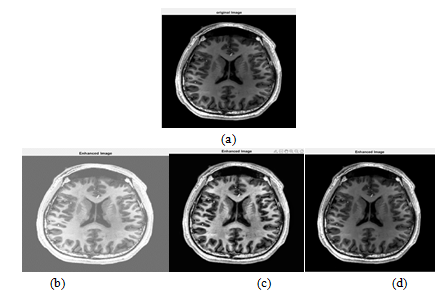
Figure.4.1: Enhancement Results for MRI of brain (a) Original image; output images: (b) HE (c) AHE (d) AHA
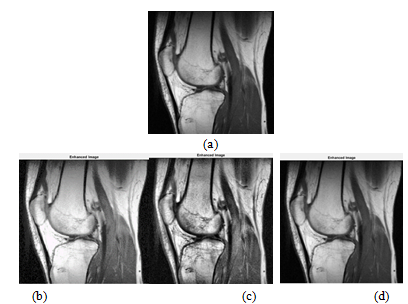
Figure.4.2: Enhancement Results for MRI of knee (a) Original image; output images: (b) HE (c) AHE (d) AHA

Figure.4.3: Enhancement Results for cat (a) Original image; output images: (b) HE (c) AHE (d) AHA
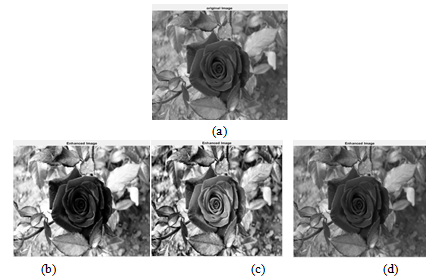
Figure.4.4: Enhancement Results for rose (a) Original image; output images: (b) HE (c) AHE (d) AHA

Figure.4.5: Enhancement Results for house (a) Original image; output images: (b) HE (c) AHE (d) AHA
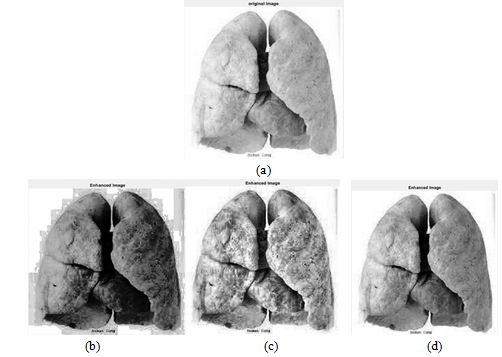
Figure.4.6: Enhancement Results for lungs (a) Original image; output images: (b) HE (c) AHE (d) AHA
Table 5.1: Quantitative evaluation of improved images produced by different contrast-enhancement methods
|
IMAGES |
METHODS |
SSIM |
FSIM |
PSNR |
|
BRAIN
|
HE AHE AHA |
0.3535 0.6034 0.9208 |
0.9943 0.9943 0.9974 |
7.6014 17.2268 19.1972 |
|
KNEE |
HE AHE AHA |
0.7887 0.6981 0.9430 |
0.9948 0.9886 0.9994 |
15.8525 17.1666 24.4530 |
|
CAT |
HE AHE AHA |
0.7466 0.7474 0.8814 |
0.9782 0.9870 0.9961 |
16.0334 16.4438 16.8746 |
|
GIRAFF |
HE AHE AHA |
0.8184 0.8989 0.9956 |
0.9899 0.9890 0.9999 |
16.2278 20.4379 29.4646 |
|
HOUSE |
HE AHE AHA |
0.7339 0.7486 1.0000 |
0.9855 0.9905 1.0000 |
14.3334 15.6961 54.9553 |
|
LIVER |
HE AHE AHA |
0.6440 0.7741 0.9879 |
0.9751 0.9909 0.9999 |
10.8989 18.5542 25.9933 |
Table 5.1 tabulates various performance metrics like SSIM, FSIM, and PSNR for a set of images processed by several image enhancement techniques.
Conclusion
A. Conclusion In this project, we implemented an image contrast enhancement method using the Artificial Hummingbird Algorithm (AHA). The primary objective was to optimize the gamma correction parameter to enhance the visual quality of the image. The key steps involved in the algorithm include initializing a population of gamma values, evaluating their fitness based on image quality metrics, and iteratively updating the population through guided and territorial foraging strategies. The effectiveness of the enhancement was evaluated using several quality metrics: SSIM, FSIM, and PSNR. The algorithm successfully improved the contrast of the image, as evidenced by the calculated values of these metrics, demonstrating the potential of AHA in image enhancement tasks. B. Future Works For future work, several enhancements can be explored to improve and extend the current project. Implementing multi-objective optimization can balance various quality metrics like SSIM, FSIM, and CII. Developing adaptive gamma correction that adjusts dynamically based on local image characteristics could yield better results. Benchmarking AHA against other state-of-the-art algorithms such as Genetic Algorithms, Particle Swarm Optimization, and Deep Learning-based methods will help evaluate its efficacy. Enhancing computational efficiency is crucial for real-time applications, particularly in video processing. Testing the algorithm across diverse image types, including medical, satellite, and low-light images, will validate its versatility. Improving the fitness function with perceptual quality metrics and creating an interactive user interface for fine-tuning enhancement parameters can enhance user experience. Additionally, exploring hybrid approaches by combining AHA with other enhancement techniques like histogram equalization or unsharp masking can leverage the strengths of multiple methods.
References
[1] Pankaj Kandhwaya, Ashish Kumar Bhandari, Anurag Singh,’ A novel reformed histogram equalization based medical image contrast enhancement using krill herd optimization’, Elsevier, Biomedical Signal Processing and Control, Vol. 56, 2020. [2] Upendra Kumar Acharya , Sandeep Kumar,’ Particle swarm optimized texture based histogram equalization (PSOTHE) for MRI brain image enhancement’, Optik, Vol. 224, 2020 . [3] Wan Azani Mustafa, Haniza Yazid, Mastura Jaafar , Mustaffa Zainal, Aimi Salihah AbdulNasir,’ A Review of Image Quality Assessment (IQA): SNR, GCF, AD, NAE, PSNR, ME’, Journal of Advanced Research in Computing and Applications, Vol. 7, Issue 1, pp. 1-7, 2017. [4] Jia Chena, Weiyu Yua , Jing Tianb, Li Chenb, Zhili Zhoud,’ Image contrast enhancement using an artificial bee colony algorithm’, Swarm and Evolutionary Computation. [5] Chenyi Zhaoa, Zeqi Wanga,Huanyu Li,Xiaoyang Wua, Shuang Qiaoa,Jianing Sun,’ A new approach for medical image enhancement based on luminance-level modulation and gradient modulation’, Biomedical Signal Processing and Control, Vol. 48, pp. 189–196, 2019. [6] Eyob Mersha woldamanuel,’ Grayscale Image Enhancement Using Water Cycle Algorithm’, IEEE Access, Multidiciplinary, Vol. 11, 2023. [7] Pourya Hoseini, Mahrokh G. Shayesteh, “Efficient contrast enhancement of images using hybrid ant colony optimisation, genetic algorithm, and simulated annealing”, Digital Signal Processing, Vol. 23, pp. 879–893, 2013 [8] Kankanala Srinivas, Ashish Kumar Bhandari,’ Low light image enhancement with adaptive sigmoid transfer function’, IET Image Process, Vol. 14, Issue. 4, pp. 668-678, 2020. [9] Ammar Mansoor Kamoona, Jagdish Chandra Patra,’ A novel enhanced cuckoo search algorithm for contrast enhancement of gray scale images’, Vol. 85, pp. 105749, 2019. [10] Madheswari Kanmani,Venkateswaran Narsimhan,’ An image contrast enhancement algorithm for grayscale images using particle swarm optimization’, Springer Nature 2018. [11] Krishna Gopal Dhal,Swarnajit Ray,Arunita Das,Sanjoy Das,’ A Survey on Nature-Inspired Optimization Algorithms and Their Application in Image Enhancement Domain’, CIMNE, Barcelona, Spain 2018. [12] Yuanping Zhou, Changqin Shi, Bingyan Lai , Giorgos Jimenez,’ Contrast enhancement of medical images using a new version of the World Cup Optimization algorithm’, Quantitative Imaging in Medicine and Surgery, Vol. 9, No 9, 2019. [13] W. Zhao, Z. Zhang, L. Wang, Manta ray foraging optimization: An effective bio-inspired optimizer for engineering applications, Vol. 87, pp. 103300, 2020.
Copyright
Copyright © 2024 Laishram Avinash Singh, Dr. Harsha M. V. This is an open access article distributed under the Creative Commons Attribution License, which permits unrestricted use, distribution, and reproduction in any medium, provided the original work is properly cited.

Download Paper
Paper Id : IJRASET63922
Publish Date : 2024-08-09
ISSN : 2321-9653
Publisher Name : IJRASET
DOI Link : Click Here
 Submit Paper Online
Submit Paper Online

